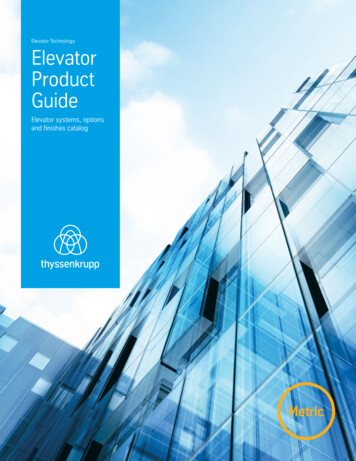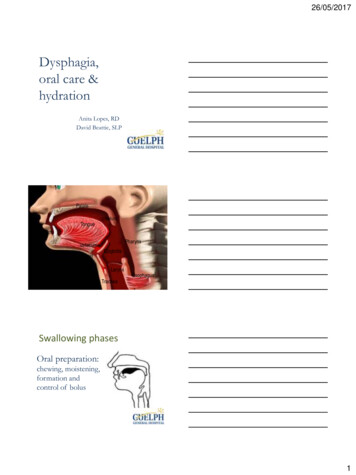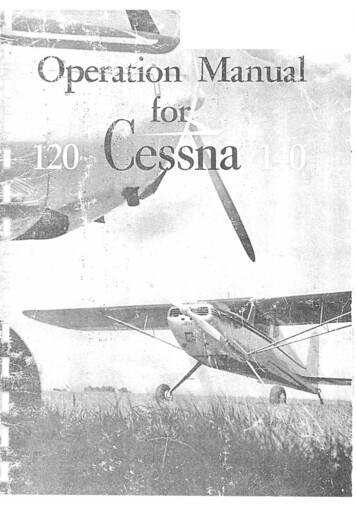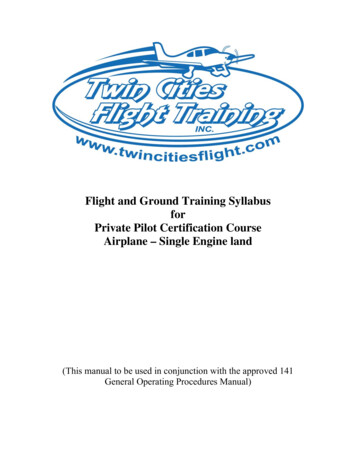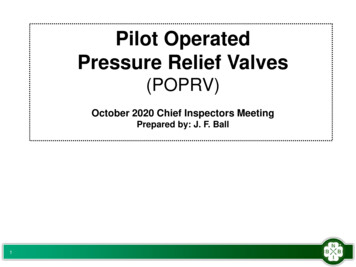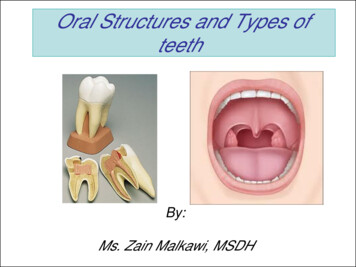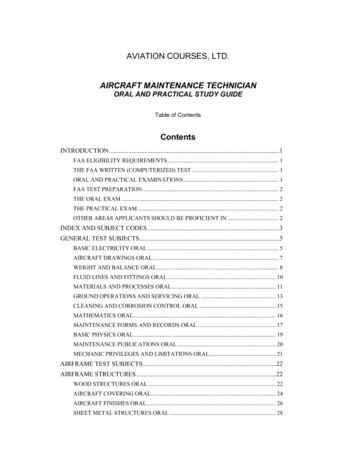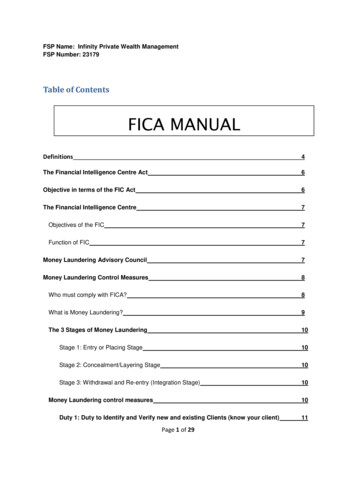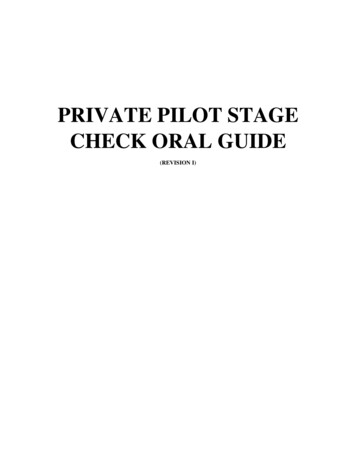
Transcription
PRIVATE PILOT STAGECHECK ORAL GUIDE(REVISION I)
REFERENCESFAR/AIMPHAKAC 00-45GPOHRECOMMENDED READINGSCertificates and DocumentsAC 00-6A
What documents must you have with you to fly the airplane? (61.3)Pilot certificate, medical certificate, and government issued photo ID*as a student pilot, these documents in addition to your logbook (to show endorsements) are onlyrequired when acting as PIC (solo flight)What are your limitations as a student pilot? (61.89)1. No passengers2. Cannot carry property for compensation or hire3. Cannot fly in furtherance of a business4. Cannot fly with a flight or surface visibility of less than 3sm during the day and 5sm at night and flightmust be made with visual references to the surface.What privileges and limitations apply to private pilot? (61.113) (91.146)Privileges – Act as PIC and carry passengers – conduct search and rescue operations; fly forcharitable, non-profit, or community event; act as an aircraft salesman if you have at least 200hours.Limitations – Cannot fly for hire; must pay no less than pro rata shareDo you need to take your logbook with you? (61.51)Only as a solo student pilot on a cross country flightWhat type of pilot certificate do you have? Does it expire? (61.19)Under 40, a student pilot certificate expires after 60 calendar monthsOver 40 it expires after 24 calendar monthsPPL, CPL, CFI, Ground Instructors, and ATP certificates are issued without an expiration date.
How do we keep our pilot certificate current? (61.56, 61.57)Student pilot: with valid medical certificatePPL: Flight review every 24 calendar monthsWhat are the currency requirements for carrying passengers? (61.57)3 take offs and landings within the preceding 90 days in an aircraft of the same category, class andtype if required. At night, these 3 landings must be made to a full stop.Night definition? When can you perform required night landings? (1.1, 61.57)Night the time between evening civil twilight and morning civil twilightNight landings can be logged 1 hour after sunset to 1 hour before sunrise.How long is a medical certificate valid for? (61.23)Under 4040 and Older
What documents should be in the aircraft before flight? ARROW (91.9, 91.203)Airworthiness CertificateRegistrationRadio License (required for international flight)Operating Limitations (found in the POH)Weight and Balance equipment listWhen will an aircraft registration certificate expire? (PHAK 8-6)3 yearsWhich weight and balance information must be in the aircraft, the one on the takeoff datacard or the one in the airplane flight manual?Updated weight and balance equipment list in the AFMWith respect to the certification, privileges, and limitations of airmen, what do category,class, and type mean? (61.5)Category: Airplane, Rotorcraft, Glider, Lighter-Than-Air etc.Class: Single Engine Land/Sea, Multi Engine Land/Sea
Type: specific to aircraft – only required for aircraft with a max gross weight equal or greater than12,500lbs, turbojet, or any aircraft specified by the FAA to require one (61.31)If a pilot changes his permanent mailing address, how long can the pilot continue to exercisethe privileges of their pilot certificate without notifying the FAA? (61.60)30 daysAirworthiness ConsiderationsDoes an Airworthiness Certificate ever expire?Not as long as inspections are kept up to date and manufacturer's original design is adhered toDoes the POH meet the requirement of having an AFM? (PHAK 8-2)Yes. The POH for most light aircraft built after 1975 is also the FAA designated AFM.Who says we have to follow the POH? (91.9)FAR 91.9 states, “ no person may operate a civil aircraft without complying with the operatinglimitations specified in the approved Airplane or Rotorcraft Flight Manual ”Who is responsible for ensuring an aircraft is maintained in an airworthy condition?(91.403)The owner/operatorDiscuss AVIATES. Required InspectionsAnnual – every 12 calendar months (91.409)VOR – every 30 days for IFR (91.171)
100 hour if airplane is being operated for hireAltimeter/Pitot Static – 24 calendar months; required for IFR flight (91.411)Transponder – 24 calendar months (91.413)ELT – 12 calendar months or after 1 hour cumulative use or half of battery life (91.207)Service bulletins and ADs complied withWhat is an Airworthiness Directive? Is it mandatory? (PHAK 8-12)FAA issued order to fix a known issue. It is mandatory.What different kinds of AD’s are there?Emergency – These require immediate compliance before flightOne Time – After the AD is complied with once, there is no further need to address the specifiedissueRecurring – This AD must be complied with at the specified interval.Can you over fly an annual? 100 hour? (91.409)The only way to overfly an annual is to obtain a special flight permit from the FSDO.A 100 hour inspection may be overflown by no more than 10 hours and only if enroute to theplace where the inspection will be done. An annual inspection can be substituted for the 100 hourhowever, a 100 hour cannot substitute an annual inspection.Do you need to have an ELT in the airplane today? (91.207)Not needed for training within 50 nm of home airport
When does an ELT battery have to be replaced or recharged? (91.207)12Calendar Months1Hour Cumulative Use.5Half of Battery LifeWhat equipment and instruments do you need to have in the airplane for today’s flight?ATOMATOFLAMES (91.205b)AltimeterTachometerOil temperature gaugeMagnetic compassAirspeed IndicatorTemperature gauge (for liquid cooled engines)Oil pressureFuel quantity gaugeLanding gear position indicator (for retractable landing gear)Anti-collision lights – Aviation red or white (e.g. red rotating beacon or white strobes)Manifold pressure gauge (for airplanes with a constant speed propeller)ELT
SeatbeltsHow about if you were to fly tonight? FLAPS (91.205c)Fuses 3 of each kind or 1 complete setLanding light if airplane is being flown for hire (including flight training)Anti-collision lightsPosition lights – Also called navigation lights – red on the left side, green on the right and whiteon the tailSource of electricity – Battery or alternatorWhat would you do if you found that the landing light was inoperative? (91.213)Cannot fly at night per the FARs – During the day you would deactivate or remove the componentand placard it inoperative (deactivating could be as simple as pulling the circuit breaker out)Can you fly an airplane with known inoperative equipment?Yes, if it is not included in 91.205 and it has been deactivated/removed and placarded inoperativeWhat is a Minimum Equipment List? (PHAK 8-9)An FAA approved list of equipment that can be inoperativeDo we have one? What do we have?No. We adhere to the regulations in 91.205 and 91.213 (d)Can an aircraft owner change an MEL?If a change is sought, a letter and a proposed MEL that is based off of the Master MEL must besent to the FAA for approval
Performance and LimitationsWhat are the four forces of flight?Lift Weight Thrust DragWhat are the primary flight controls? (PHAK 5-3)What are the secondary flight controls? (PHAK 5-8)
Flaps, leading edge devices, spoilers, and trim systems (anti-servo tab)How is lift created? (PHAK 3-4)Newton's 3rd law - Airfoils accelerate airflow downward. The equal and opposite reaction asdescribed by Newton forces the airfoil upwards.Bernoulli's Principle – As the velocity of a fluid or gas increases the pressure decreases. Highspeed air over the upper surface creates low pressure area while comparatively lower speed airbeneath the wing creates high pressure which produces an upwards force that contributes to thetotal lift.Explain the different types of drag.Parasite – increases with speedSome types of parasite drag include form, skin friction, and interference drag.Form drag is caused by the shape of the aircraft and the airflow around it. Anything that sticks offrom the fuselage as well as the fuselage itself contributes to this (e.g. antennas, pitot mast, enginecowling)Skin friction drag is caused by air slowing down as it moves across the surface of the aircraft.Rivets, dirt, or anything that makes the surface less smooth adds to this type of drag.Interference drag is caused by intersecting airstreams from different parts of the aircraft. Take, forexample, the area where the wing is attached to the fuselage. Since the wing accelerates therelative wind, this airstream will be relatively faster than the wind moving over the fuselage.When these two airstreams meet, turbulent eddies form and this produces drag.Induced – byproduct of lift, decreases with speed
High pressure airflow from beneath the wing has the tendency to spill over the wingtips toequalize the lower pressure above. When this happens, turbulent whirl pools called wingtipvortices form and create drag. Also, any time the angle of attack is increased, a portion of thewing’s lift vector is angled backwards. This too creates more induced drag.What is the airspeed where Induced and Parasite drag meet?Vg – Best glide speedThis is also described as L/D Max or the maximum lift to drag ratio.Describe the various components of an airfoil (PHAK 3-8 Fig. 3-6)What is camber? Can we change it?Curvature of the wing – it can be changed by extending/retracting flapsWhat is angle of incidence? Can we change it?The angle between the wing chord line and the fuselage – it cannot be changedWhat is center of gravity? What happens when it moves forward/aft? (PHAK 4-38)
CG is the point where the aircraft is balanced or the place where the entire weight is concentratedForward CGAft CGLower Cruise SpeedHigher Cruise SpeedHigher Stall SpeedLower Cruise SpeedMore StableLess StableFavorable Stall RecoveryAdverse Stall RecoveryDifficulty in rotating and rounding out duringShorter arm between CG and control surfaces onlanding. Also, difficulty in steering can result.the tail makes them less effective.Forward CG – This is a nose heavy condition that results in the pilot having to use more backpressure to maintain a level flight attitude. More tail down force means that the wings mustovercome this weight. The cruise speed is lower because of this. The imposed load increases thestall speed.Aft CG – Less tail down force (provided by our stabilator) is required when flying with an aft CG.This means that the wings also have less of this load to overcome therefore there is less overalldrag allowing for a faster cruise speed. Because stall speeds increase with load, an aft CG also
means that the stall speed is lower. The distance between the CG and the stabilator is crucial inmaintaining authority over the control surface. An aft CG means a shorter arm and thus, lessauthority. This translates into adverse stall recovery characteristics.What causes a wing to stall? (PHAK 4-22)The wing will stall anytime the critical angle of attack is exceeded.How does temperature change the takeoff distance? Weight? Air density? (PHAK 10-2 and9-2)High temperatures less dense airLess dense air exerts less force on airfoils (wings and propeller) making them less efficient andalso deprives the engine of power. This leads to longer take off rolls and decreased climbperformance.Higher weight also leads to longer take off rolls and increased landing distance because it takesmore engine power to accelerate a heavy aircraft to Vr and more braking power to slow theaircraft down.What are the different types of airspeeds? Altitudes? (PHAK 7-6 and 10-17)IAS – indicatedCAS – calibrated (IAS corrected for instrument, position, and installation error) It is equal to TASin the standard atmosphere at sea level.TAS – true (CAS corrected for non-standard temperature and pressure)GS – ground (TAS corrected for wind)
Indicated – altitude as read off of the altimeter with appropriate settingPressure – vertical distance above the standard datum plane: a theoretical plane where sea levelpressure exists. It can be found by setting 29.92 in Kollsman window and reading the altitude.Density - Pressure altitude corrected for non-standard temp.True – vertical distance above sea level (MSL)Absolute - vertical distance above terrain (AGL)Calculate pressure/density altitude.PA Altitude (field elevation) (29.92 - current altimeter setting) x 1000DA PA [120 x (outside air temp.in degrees Celsius – standard temp. for that altitude)]What factors affect air density? (PHAK 10-4)Heat – warm air expands is less denseHeight (altitude) – air at higher altitudes is less denseHumidity – A parcel of humid air is less dense because water molecules take up more room andspread out the air molecules.What are the maximum ramp, takeoff & landing weights for the airplane? (POH 1-4)2550lbsWhy is the ramp weight different from takeoff weight? (POH 1-8)Ramp weight max weight approved for ground maneuvers (taxi)Takeoff weight max weight approved for takeoff run
How do you find the crosswind component? Max crosswind component for aircraft? (AIM4-3-3) (POH 4-1)Max demonstrated crosswind is 17 knotsHow does wind affect takeoff and landing?Headwinds decrease takeoff and landing roll – Tailwinds increase the takeoff and landing rollHow much does one gallon of 100LL weigh? (PHAK 9-5)6 lbsDiscuss V-speeds (PHAK 10-17) (POH section 2)Vso 45 – stalling speed in the landing configurationVs1 50 – stalling speed in specified configurationVy 76 – best rate of climb (greatest altitude gain per unit of time)Vx 64 – best angle of climb (greatest altitude gain per distance over the ground)Vfe 102 – flap extension speedVa 89-113 – design maneuvering speed (heavier aircraft higher maneuvering speed)Vno 125 – maximum structural cruising speed (flight above this speed only permissible in smoothair)Vne 154 – never exceed speedDoes Vg change? Why?Vg is only 76 at max gross weight. Vg will be slower at a lower weight
When would you want to climb at Vx? How about a Vy climb?Vx is used to clear an obstacleVy is used to get to altitude in the shortest amount of timeExplain left turning tendencies. TGAS (PHAK 4-26)Torque – clockwise spinning prop causes airplane to roll left about the longitudinal axis. This is anexample of Newton’s 3rd law.On the ground, this left rolling tendency causes more weight to be on the left main gear therebyincreasing the friction and inducing a left yawing tendency.Gyroscopic Precession – During a descent the tail rises and causes a force to felt on the top of thepropeller. The resultant force is therefore 90 degrees ahead in the direction of the rotation(RIGHT SIDE of propeller) causing a left yawing tendency. This is mostly associated withtailwheel aircraft because on their takeoff roll the tail has to be raised and this creates a left turningtendency.*This is otherwise a right turning tendency in a climb because the effective force would now be atthe bottom of the propeller and thus the effective force would be on the LEFT SIDE. The otherleft turning tendencies, however, make this effect negligible.Asymmetrical Thrust – In a climb, the descending propeller blade (RIGHT SIDE) has a greaterangle of attack and therefore creates more lift. This causes a left yawing tendency.Spiraling Slipstream – Propeller wash strikes the aircraft of the left side of the vertical stabilizercausing a left yawing tendency.*The slipstream also strikes the right wing from above causing a right rolling tendency. The leftrolling tendency from torque, however, makes this effect negligible.
All of these tendencies are more pronounced at low airspeeds, high angles of attack, and highpower settings.Explain Stability (PHAK 4-13)Lateral Stability – Resistance to rollWing dihedral is what gives our aircraft lateral stability. The soft V shape means that during a sideslip, the lower wing has a greater angle of attack and this helps return it to equilibrium.Effectively managing fuel can also influence this because if the fuel load is imbalanced, one wingwill be lower than the otherLongitudinal Stability – Resistance to pitchFlying “inside of the envelope” is the greatest factor here. CG must be within limits to maintainlongitudinal stability.Vertical Stability – Resistance to yawThe size of the vertical stabilizer and the area of the fuselage aft of the CG contribute to verticalstability. The bigger and father aft the vertical stabilizer is, the greater the stability.Positive Stability – Tendency to return to equilibriumNeutral Stability – Tendency to stay in new positionNegative Stability – Tendency to continue to move away from equilibriumStatic Stability – Initial tendencyDynamic Stability – Response over time
Operations of Systems (PHAK Chapter 7) (POH)Describe the pitot-static flight instrumentsAirspeed Indicator – This is the only instrument that uses both the pitot and static ports. Itmeasures the difference between dynamic pressure (ram air entering the pitot tube) and static
pressure (air that is unaffected by the aircraft’s flight path). Ram air exerts a force on a diaphragminside of the instrument. The instrument case is full of static air.Altimeter – This measures the difference between static pressure inside of the instrument case andstandard pressure (29.92” Hg) sealed inside of an aneroid wafer. When the airplane is climbingand ambient pressure begins to decrease, the wafer is able to expand because the air that is sealedinside is now of higher pressure. The altimeter is a sensitive altimeter meaning that it can becalibrated to the local barometric pressure by adjusting the Kollsman window.VSI – Measures the difference between static pressure and static pressure that is subject to acalibrated leak approximately every 6-9 seconds.How do the pitot- static instruments respond to blockages?
*Note the very first error – this error would be highly uncommon in the Piper Archer becausethere is no drain hole on the pitot mast like most other training aircraft. If there is a blockage in the pitotmast, the drain hole would more than likely be unaffected.Describe the gyroscopic instrumentsThe Gyroscopic instruments are powered by an engine driven vacuum pump with the exception ofthe turn coordinator which is electrically powered. The two principles that gyroscopes operate off
of are:Rigidity in space: while spinning, a gyroscope will tend to stay fixed in its plane of rotation. Thinkof a bicycle wheel. With enough momentum, you are able to stay naturally balanced.Precession: when a force is applied to a gyroscope, the resultant force is felt 90 ahead in thedirection of the rotation.Attitude Indicator – Rotates in the horizontal plane and operates off of the principle of rigidity inspace. The aircraft pitches and rolls around the erect gyroscope. The effects of precession are notfelt because pendulous vanes attached to the base of the gyro duct high pressure air from thevacuum through small doors that open and close by the force of gravity to keep the gyro in itsoriginal position.Heading Indicator – Rotates in the vertical plane and operates off of rigidity in space as well. Asthe aircraft yaws around the gyro, a gear inside of the instrument case rotates the compass card toshow the magnetic direction. Precession caused from aircraft movement and friction causes errorthat must be corrected by resetting the heading indicator to the magnetic compass approximatelyevery 15 minutes.Turn Coordinator – This electrically powered gyro rotates in the vertical plane and it uses precession tomeasure rate of turn and rate of roll. When the aircraft yaws, the gyro precesses and the airplane on theface of the instrument indicates the direction and rate of the turn. Notice in the diagram of the instrumentthat it is slightly canted upwards. This is so rate of roll can be indicated as well. When the aircraft begins abank the aircraft will also indicate the direction of the bank. If it is a rapid roll the airplane will respond bybanking more steeply. Once the turn is established it will properly indicate the rate of the turn.Explain the errors associated with the magnetic compass
Variation – Since the magnetic north pole and the geographic North Pole are not collocated, we need toconsider this when planning flights. Easterly variation is subtracted from true heading while westerlyvariation is added to get our magnetic heading. Remember: East is least and West is best!Deviation – Since a compass depends on aligning with the Earth’s magnetic fields to read accurately, anykind of other local magnetic fields will cause an error known as deviation. This other magnetic fields areproduced from electrical currents from the aircraft avionics and are change on different headings. Thecompass correction card located on the compass tells the pilot which compass heading to steer to for adesired magnetic heading.Dip Errors – While flying on a north or south heading, these turning errors are most pronounced. Whileflying a north heading and turning to the left, the compass will initially show a turn in the opposite directionand lag behind the turn. When on a south heading, the compass will lead the turn and show that the turn isbeing made a much faster rate than it actually is.*Imagine that north is home to the compass. While at “home” the compass wants to stay there during a turn andwill lag behind before it finally decides to catch up reluctantly. Conversely, while most far away from home on asouth heading, when a turn is commenced, the compass gets excited and races there (leading the turn)Acceleration Error – While on east or west headings, acceleration results in a slight turn to the north.Deceleration results in a slight turn to the south. The rule is: ANDS Accelerate North Decelerate SouthOscillation Error – A combination of all of these errors and results in the compass swinging back and fortharound the headings being flownDescribe the engine in this aircraft. (1-3)Naturally aspirated 180 HP Lycoming 0-360-A4M horizontally opposed 4 cylinder air cooleddirect drive carbureted reciprocating piston engineWhat does “normally aspirated” mean? (PHAK 6-11)Ambient air enters the intake manifold – there is no turbo or supercharger
What is used to cool the engine? (PHAK 6-16)Air intakes at the front of the engine cowling allow outside air to cool the cylinders. Fins on thefilters allow a greater surface area to be exposed and thus cooled by the air. Engine oil is crucialin internal engine cooling.Why do we need oil in the engine?Lubricates - all of the engine’s moving partsCools – reduces friction and removes heat from the cylindersSeals – it creates a seal between the cylinder walls and pistonsCleans – carries away contaminants inside of the engineWhat is meant by four-stroke”? (PHAK 6-3)1. Intake valve opens as downward moving piston pulls fuel/air mixture into cylinder2. Intake valve closes as piston moves back up and compresses this mixture3. While this piston is in its upmost position the spark plugs ignite the mixture and force thepiston back down4. As the piston rises, the exhaust valve opens and expels the exhaust gas from the cylinder
What is the oil capacity of your aircraft? (1-3)8 qtsWhat type of oil do we use?W15W-50What type of propeller do we have? (1-3)76" Sensenich fixed pitchWhat does the mixture control do? (PHAK 6-8)
As we gain altitude, the air becomes less dense. If we do not make any adjustments then we willhave an excessively rich fuel/air mixture. This can result in carbon build up in the cylinders whichcan foul the spark plugs and reduce engine power. Leaning the mixture decreases the fuel flow andcompensates for this.Describe the fuel system. (7-8)We have one fuel tank per wing each with a 25 gallon capacity. 1 on these gallons is unusablewhich mean that of 50 total gallons, only 48 are useable. Fuel is moved from the tanks to theengine by an engine driven fuel pump. The boost pump is electrically powered and is used as abackup. A fuel selector valve allows the pilot to control which tank he/she would like to pull from.There is no option to pull from both at the same time. Fuel quantity and pressure gauges are in thecockpit to make the pilot aware of the current fuel situation. Fuel enters the float type carburetorvia a fuel inlet and is drawn into the venturi to be mixed with air through a discharge nozzle priorto reaching the cylinders. Underneath both wings near the landing gear is a sump to drain fuelsamples from each tank. This is the lowest point of either tank. The lowest point of the fuel systemcan be drained from the sump located on the front left side of the aircraft.What color is 100LL? How about other types of fuel? What happens when they are mixedtogether? (PHAK 6-27)
Mixed fuel becomes clearWhat could be other types of clear liquid?Jet AWhy do you drain a sample of fuel before each flight?Fuel weighs roughly 6lbs and water weighs about 8lbs. Because it is heavier it always sinks to thebottom of the fuel tanks. This is why we drain from the lowest points in the fuel system. We alsowant to visually inspect the fuel for the proper grade and to make sure that it is free of sediment.What are stall strips?
They are placed on the leading edge of the wing close to the wing root to help induce a stalltowards the wing root so that pilot still has directional control with the ailerons.What type of brakes does the airplane have? (7-3)Cleveland single disc hydraulic brakesHow does the vacuum system operate? (PHAK 7-17) (POH 7-17)An engine driven vacuum pump creates suction. Air is pulled through a filter and then directed tothe instrument case. Rotor vanes on the gyros catch the air like a water wheel and cause it to rotateat a high speed. In the Archer IIIs, there is also an electrical vacuum pump to be used as a backup.Describe the electrical system. (7-10 - 7-12)Archer II: 12 volt batt. 14 volt system 60 amp alternatorArcher III: 24 volt batt. 28 volt system 70 amp alternatorThe electrical system provides power to all of the radio equipment, the engine gauges, turncoordinator, stall warning horn and all the lightsThe magnetos are a self-sustaining source of electricity. As long as the propeller and crankshaft isturning, they will continue to provide electricity to the spark plugs and the engine will run. Thismeans that in the event of an electrical failure, you will NOT lose your engine.National Airspace System (PHAK chapter 14)
What is the difference between controlled and uncontrolled airspace?Class G is the only uncontrolled airspace. ATC has no jurisdiction.What are the different classes of airspace? Requirements? Weather minimums?A – FL 180 to FL 600 – Instrument Rating and IFR flight plan needed – Mode C Transponder and2-way radio communication – no weather minimumsB – Upside down wedding cake design up to 10,000 MSL – Endorsement needed if student pilot –Clearance from ATC required to enter – Mode C Transponder required any time within 30 nm(mode C veil) – 3 miles visibility and clear of cloudsC – Inner core 5 nm radius and from surface to 4500 AGL – outer core 10 nm radius and from1200' AGL to 4000' AGL – Mode C Transponder and 2 way radio communication – 3 milesvisibility and 1000' above 500' below and 2000' horizontal from cloudsD – 4 nm radius and from surface to 2500' AGL – 2 way radio communications – 3 miles visibilityand 1000' above 500' below and 2000' horizontal from cloudsE – Can start at the surface, 700' AGL, or 1200' AGL and may extend up to but not including FL180 – Class E also exists above FL 600 – No equipment requirements - Below 10,000’: 3 milesvisibility and 1000' above 500' below and 2000' horizontal from clouds – Above 10,000’: 5 milesvisibility and 1000' above 1000' below and 1 mile horizontal from cloudsG – uncontrolled airspace – may start at the surface and can go as high as 14,500' MSL or 1200'AGL – no equipment requirements – Below 1200' AGL : 1 mile visibility and clear of clouds –Above 1200' AGL but below 10,000' MSL : 1 mile visibility and 1000' above 500' below and2000' horizontal from clouds – At night: 3 miles visibility and 1000' above 500' below and 2000'horizontal from clouds – Above 10000' : 5 miles visibility and 1000' above 1000' below and 1 milehorizontal from clouds
Class E andG above10,000'5-111Class C,D,Eand G atnight3-152Class B3 - clear ofcloudsClass G below10,000'1-111Class G below 1200'AGL1 - clear of cloudsWhat airspace are we in right now?Class DWhat altitude does KMYF airspace go up to?2,900'What airspace is directly above KMYF airspace?Class E begins above 2900’ and continues until 4800’ where it becomes class B.
What are the different types of Special Use Airspace? WCRAMP (AIM 3-4-1) (PHAK 14-3)Warning Areas – Extends from 3nm outward from the U.S. coast – invisible hazardous to nonparticipating aircraft.Controlled Firing Areas (does not appear on charts) – Activities that could be hazardous aresuspended immediately when a spotter detects an aircraft.Restricted – Unusual and oftentimes invisible hazards such as artillery or missile firing. When therestricted areas is active pilots will need to get permission from the controlling authority to enter.Alert – May contain a high volume of pilot training or unusual aerial activity. No clearance isneeded to enter but all pilots should be very alert.Military Operation Area – Military training such as aerial intercepts, formation flying, and lowaltitude tactics is conducted in these areas. Contact FSS to obtain hours of operation and it isadvised to contact controlling agency for traffic advisories. Permission is not needed to enter, butpilots must exercise extreme caution.Prohibited – Areas designated for national security or welfare. Flight in this area is prohibited.What are the different types of "Other Airspace Areas"?Local Airport Advisory – operated within 10sm or airport with FSS but no operating controltower.Military Training Routes – Military aircraft travelling in excess of 250ktsRoutes designated by (IR) are IFRRoutes designated by (VR) are VFR when visibility is 5sm or greater and ceilings are at
Pilot certificate, medical certificate, and government issued photo ID *as a student pilot, these documents in addition to your logbook (to show endorsements) are only required when acting as PIC (solo flight) What are your limitations as a student pilot? (61.89) 1. No passen

